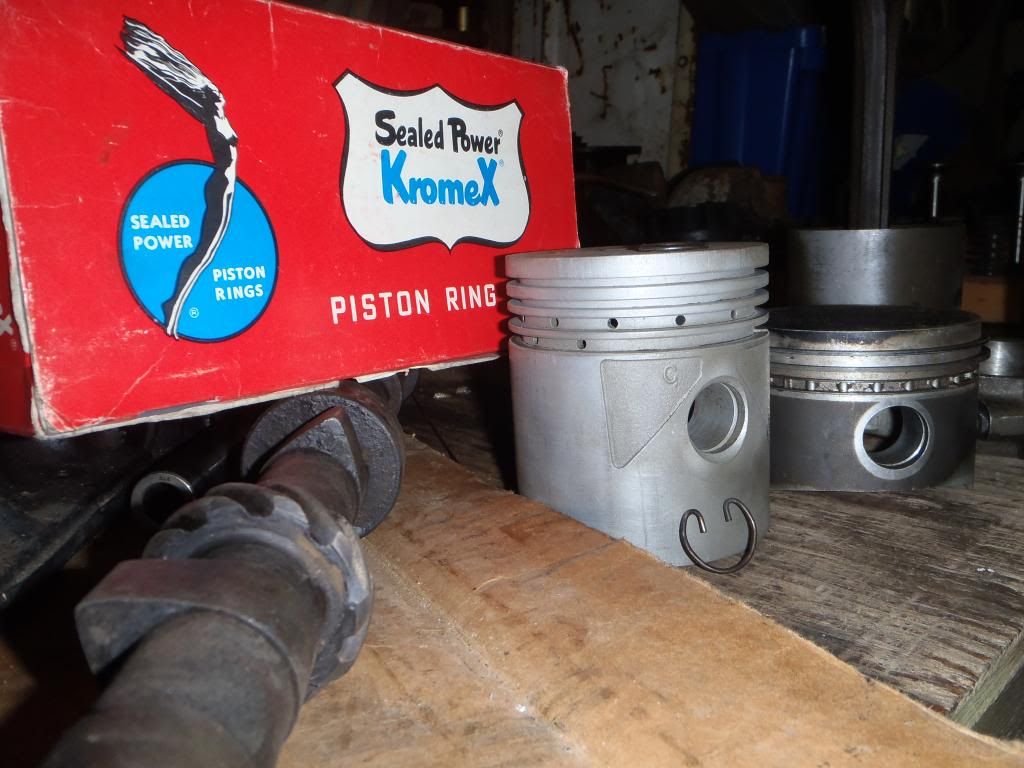Kaegi wrote:is rod ratio another way to say lighter pistons
I had never heard of rod ratios before reading a post @
http://www.inliners.org/ubb/Forum8/HTML/000021.html i will let hudson tell you :
we will pick up on the page were active inliner Hudson gets into rod ratio's
"hudson"
The rod lengths in these engines, both series, differs in length according to stroke. The longer the stroke, the shorter the rod. Its possible to increase your torque output at lower rpms by simply swapping rods with a shorter stroke engine and shaving off the piston head a smidge. A very good rod length/stroke ratio is around 1.75:1. If you check out the rod lengths vs. stroke in most flatties - you'll find something close to this number, that's why they seem to lug so smoothly at lower rpms than their bigger cid ohv cousins, who consequently run ratios around 1.55 with not much room to improve.
In the tractor world, Minneapolis Moline tractors built pre '55 all had
stock rod ratios of 2:1, this is the ultimate rod ratio - my
stock 40 hp Moline 4 cly. can show up a 66 hp IH 6 cly. on the pto any day of the week grinding corn @ 1000 rpm less at the
we pick back up with hudson farther down the page
"Hudson
The 1.75 is not ideal, but the reasoning behind calling it ideal is that the greatest increase in torque is attained at this ratio. In other words, if the torque increase due to rod length was represented in a curve, 1.75:1 would be a short plateau at the end of a steep rise. The apex would be at 2:1 with less relative rise than up to 1.75. Any increase beyond 2:1 being very small and impractical with most engines.
Why does this become so important? Its part mechanical physics in relation to rod flex and power transmission from reciprocating to rotating, part hydrodyamics in relation to cylinder filling and scavenging, and part pyrotechnics in using the combustion gases to their best potential.
The basic physics of the matter: the longer the rod in relation to stroke, a lesser angle is present between the centerline of the cylinder and the centerline of the rod beam at any point in its travel: as it deviates from vertical at TDC and BDC. This characteristic allows more direct transmission of power to the crankpin, via the longitudinal length of the rod. In shorter ratio engines, more of this transmission is transferred to the lateral section of the rod, using up power by attempting to force the rod to bend rather than push the crankpin around.
Another enormous benefit is the increase in piston dwell near TDC and BDC. As the ratio increases the amount of crank degrees that the piston dwells near the terminal ends of the reciprocating path will increase also. In mechanical perspective, this allows the crankpin to change the direction of the reciprocating mass under less resistance. The crank also rotates more degrees past tdc before piston direction changes and reduces the relative piston speed at these two points. Put these together and you have a rod acting more directly against a crank that is already past TDC by more degrees per unit of piston travel and moving the piston slower at critical points in its travel.
Hydrodynamics? Gases and fluids share the same phyical properties with the exception of compressability. We express fluid/gas flow in CFM. We often catch on to the volume, but overlook the function of time in this expression of measure. To increase the amount of piston dwell at BDC during the intake stroke, is to allow a more complete filling of the cylinder at peak demand by allowing more "time" for the cylinder to fill at its maximum volume. In addition, to increase piston dwell at TDC during the exhaust stroke, is to maintain the cylinder's minimum volume longer for a more complete expulsion of gases through the exhaust valve. Although these properties do not change the cfm capacity of a group of cylinders, they definately change how effective an engine employs its theoretical capacity. This will effect the VE% in the classic formula ((CIDxRPM)/3456)VE%=CFM.
Now, we have exhausted the spent gases more completely, taken a denser charge into the cylinder - lets examine the pyro part of longer ratios. Again, we are dwelling at TDC longer with the wider ratio. This allows the combusting gases to reach more of their potential in a smaller space over a greater amount of time, and crank degrees. This really conserves the maximum force of the combustion at is most advantageous point against the piston head. Power is really only transmitted at its maximum at this point as the change in cylinder volume during the power stroke takes up the potential of the explosion rapidly.
The benefits of this are enormous, just ask the sbc builders how much improvement they get from just .300" of rod length. The first measurement I take on any engine is deck height above the mains' centerline. The stroke is then determined based on available rod length and piston combos to effectively use the available height.
Offsetting the wrist pin center in the direction of crank rotation will accomplish the TDC effects of the rod ratio, but speeds up the BDC end of things. In high compression and forced induction engines, the increase in lateral force on the rod, due to the exaggerated angle during its upward stroke, can bite you on the touche'. But, all things considered, if I had to build and engine with a ratio less than 1.55 - I would seriously consider offsetting the wrist pin. Offsetting the wrist pin makes it important to degree your cam closely, as the crank position at TDC will change - altering everything from cam phase to timing marks by a smidge.
You fellas have a good day!
Hudson"
Active Inliner
excerpt from
http://www.inliners.org/ubb/Forum8/HTML/000021.html ( hope I quoted that right )

I know its a lot to take in.
having three choices of rods at my disposal 265, 251 and 218 i thought i would give it a try. assuming i can find a piston that will work and at the same time give me better rings. assuming that rings on a modern piston will seal better and wear better in this application. a slow spinning torque master.
Kaegi wrote: the stock cams in flatheads are designed to run on 70 octane!
I had never considered that cam profiles changed as did gas. very interesting, now i know why new grinds offered for the 37 increase power and torque @ the same rpm. i have a shadbolt cam with an unknown profile i should take it in and have him tell me if its right for the job.
Kaegi wrote: But, with balancing, porting, cam and shaving you have the basics covered then other things could be added. here is head millling chart someone posted recently.

im the op

if my cam has a better profile i will only have to shell out for balancing. i have a selection of heads to chose from. one is even freshly planed and covered in cosmoline. i have yet to cc them.








